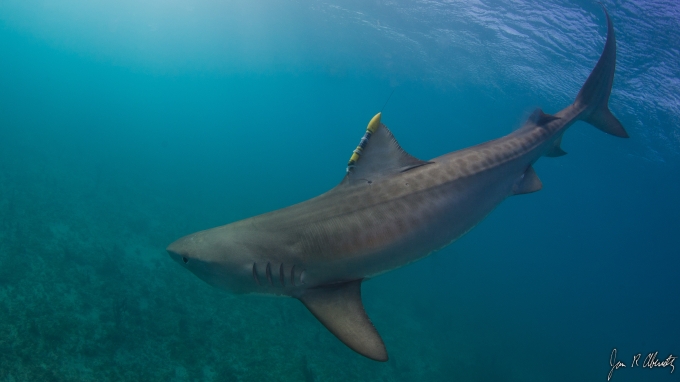Additive Manufacturing Employed for Aquatic Animal Tagging

The SeaTag tracking system attached to the fin of a tiger shark. Courtesy of Jim Abernethy, RJ Dunlap Marine Conservation Program.
May 13, 2013
The design flexibility offered by additive manufacturing (AM) makes the technology uniquely suited to a number of applications where the shape of an object is as (or nearly as) important as the functionality. Rapid prototyping obviously comes to mind where getting the shape of something right is frequently the only concern, but functional end-use products can also benefit from 3D printing.
Desert Star Systems has created a line of tags, called SeaTags, built using molds developed through AM and designed for use in the ocean. The benefit to using AM to construct the SeaTags is that each tag can be tailored for a specific species. A tag designed for use on turtles, for example, would need to be designed to have as little drag as possible, while one designed to fit on a shark’s fin would have completely different dimensions.
Each tag not only tracks the location of a particular animal, it also tracks the temperature of the water, pollutants, water salinity and other useful information for scientists. SeaTags can be powered by solar energy alone, or by a combination of solar energy and battery power. From the Desert Star Systems page:
The tags are all wrapped in a solar cell which is connected to a ‘super’ capacitor. The capacitor then powers the tag’s electronics. The tag itself can harvest energy from the sun at twice the vertical visibility of the water; therefore, if the visibility is 10m the tag can still harvest energy at 20m. The function of the capacitor is to store the energy from the sun while the tag is exposed in this harvesting area. On a full charge (approximately 15-30 mins of direct sunlight) the tag’s capacitor is capable of powering the tag for up to two weeks of total darkness.
The use of AM to create SeaTags has also allowed the company to offer the systems at a much lower price than would be the case with traditional manufacturing methods.
Below you’ll find a video that introduces the SeaTag system.
Sources: Science World Report, Desert Star Systems
Subscribe to our FREE magazine, FREE email newsletters or both!
About the Author
John NewmanJohn Newman is a Digital Engineering contributor who focuses on 3D printing. Contact him via [email protected] and read his posts on Rapid Ready Technology.
Follow DE






